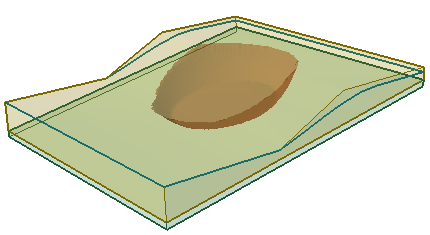Slip Surface Type
The Surface Type option in the Slip Surface Options dialog allows you to choose the following options.
The choice of Surface Type affects the available Search Methods.
Surface Type
If the Surface Generation Method = Search Methods, then you will be able to choose the shape of the slip surfaces generated by the primary Search Method. The Surface Type options are:
- Sphere
- Ellipsoid
- Spline
- Multi-Planar
- Wedge
The search process will automatically generate slip surfaces of the selected type which cut the ground topography and attempt to minimize the factor of safety obtained by transforming the shapes. Each of these shapes are defined by a set of parameters which can be varied to transform the shape:
For instance, a spherical slip surface can be generated by selecting an entry and exit point into the ground topography, and a radius. By changing the parameters of the entry and exit locations and the radius, different spherical slip surfaces with different factors of safety can be obtained. Ellipsoidal and spline surfaces are generated in a similar manner except with more parameters. For ellipsoids, there are three radii and three rotation angles. For splines, there are parameters which affect the curvature and elevation of the surface. The parameters for wedge and multi-planar surfaces are the locations of the cutting planes, which intersect to form a slip surface.
This determines the shape of all surfaces generated by the primary search method (e.g. Cuckoo Search, Particle Swarm Search). For more information about how these parameters are varied to obtain the minimum factor of safety, see the links in the previous sentence.
- If Surface Type = Sphere, then the available Search Methods are Grid Search, Cuckoo Search, Particle Swarm, Auto Refine (i.e. all search methods are applicable for a spherical surface type).
- If Surface Type = Ellipsoid, then the available Search Methods are Cuckoo Search, Particle Swarm
- If Surface Type = Spline, then the available Search Methods are Cuckoo Search, Particle Swarm
- If Surface Type = Multi-Planar, then the available Search Methods are Cuckoo Search, Particle Swarm (Note: Surface Altering Optimization is NOT available when Surface Type = Multi-Planar)
- If Surface Type = Wedge, then the available Search Methods are Grid Search, Cuckoo Search, Particle Swarm, and Auto Refine
The new Wedge analysis uses SWedge type surfaces and gives the option of two planes or two planes plus a basal joint.
External Geometry Composite Surfaces
The External Geometry Composite Surfaces option is intended for modelling a strong bedrock layer at the bottom of a model. It allows the slip surface search routines to form "composite" surfaces (e.g. spherical/planar) which conform to the lower edge of the External boundary volume.
If this checkbox is selected, then slip surfaces (e.g. spheres or ellipsoids) which intersect the bottom of the External boundary, will automatically be intersected with the External boundary, and conform to the shape of the External boundary along the bottom edge. An example is shown below.


Weak Layer Handling
See Weak Layer Overview for a detailed description of how weak layers can be handled via the options in this dialog:
- Heuristic (recommended) – varies the weak layers being activated as the search progresses (only available for Particle Swarm Optimization)
- Automatic case generation – tries all combinations of weak layers to find the most critical slip surface
- Always snap to highest layer – snaps the slip surface to the highest weak layer at any given point